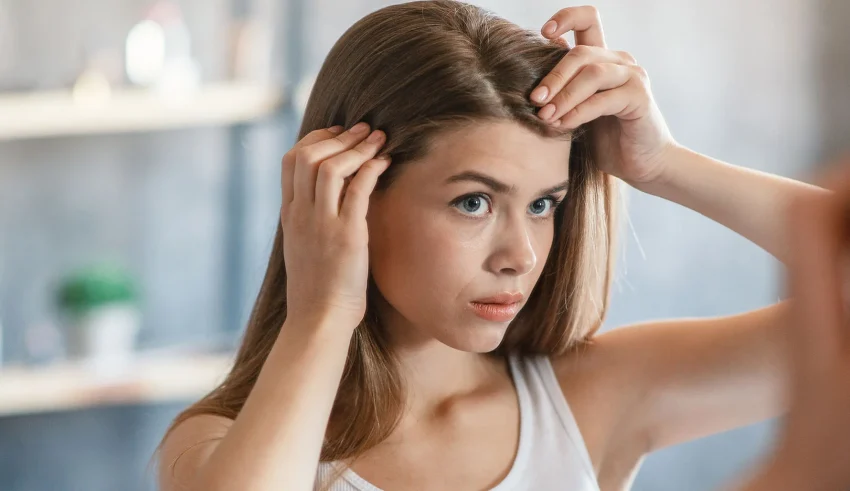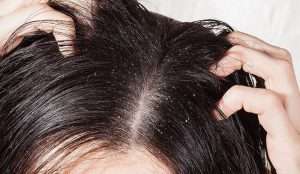
Dandruff is one of the most common and chronic conditions affecting millions of people worldwide. This condition can be embarrassing and can even affect your daily life. Dandruff can have many causes and develop in different forms. To solve the problem, it is important to identify the type of dandruff before starting treatment. In this article from The Dermo Lab and in collaboration with Dr. Amal Alrwely, we have discussed the different types of hair dandruff and how to treat them.
How is dandruff caused?
Dandruff is characterized by the presence of white flakes in the hair and is also associated with symptoms such as inflammation and itching of the scalp. Although it is a frustrating hair condition, it can be treated.
According to Dr. Amal Alrwely, dandruff can have several causes, including irritated, oily skin and a yeast fungus (malassezia) that feeds on oils on the scalp. She states that dry scalp can also cause hair dandruff.
Other causes include:
- Insufficient shampooing
- Sensitivity to hair care products
- Certain skin conditions, such as psoriasis and eczema
What are the different types of hair dandruff?
Knowing what type of hair dandruff you have is essential to get rid of the flakes and itching, and can also help you take steps to treat the underlying cause. According to Dr. Amal Alrwely, there are 5 types of hair dandruff: Dry dandruff, oily dandruff, fungal dandruff, dandruff caused by seborrheic dermatitis, and dandruff caused by psoriasis.
1- Dry skin dandruff
This is a common type of dandruff. It tends to occur more often during the winter months, as cold weather and indoor heating can dry out the skin, including the scalp.
Frequent washing of the hair using hot water can also lead to dry dandruff.
An overly dry scalp can become irritated and lose skin cells. Your scalp may itch, but not excessively. Dr. Amal Alrwely indicates that dry skin flakes are small and white.
If the itching becomes severe, you may have a more serious skin condition that needs professional attention.
2- Oily scalp dandruff
Just beneath the surface of your skin are glands that produce sebum, an oily substance that helps moisturize and protect your skin. When these sebaceous glands produce too much sebum, it can make your hair greasy.
In addition, excess sebum can clump together, irritate your scalp and cause dandruff.
Oily dandruff flakes tend to be larger than the ones caused by dry dandruff. They may be more yellow than white and may also appear oilier.
3- Fungal dandruff
Fungal dandruff is the result of a scalp infection caused by the fungus Malassezia globosa. This fungal infection spreads quite rapidly when your scalp is too oily or has a pH imbalance.
It is also highly contagious and can be spread when people share combs, towels, or hats with someone who has the infection. Malassezia produces oleic acid, which increases skin cell turnover. This leads to the formation of dandruff.
4- Dandruff caused by seborrheic dermatitis
Seborrheic dermatitis is more common in people with oily skin. It is a severe type of oily dandruff. In addition to flaking, this common scalp disorder can cause scaly red patches and itching.
5- Dandruff caused by psoriasis
Psoriasis is a chronic skin condition in which the immune system begins to attack healthy skin tissue. This leads to the rapid production of new skin cells before the old, dead skin is shed. The result is the formation of thick, scaly, silver-colored patches on the scalp, neck, knees, and back.
How to cure dandruff permanently?
Dandruff treatment can be divided into three categories:
- Anti-dandruff shampoos
- Lifestyle changes
- Hair care
Anti-dandruff shampoos
For some people, using an anti-dandruff shampoo is enough to treat the flaking. It is important to read the instructions carefully – some shampoos are for daily use, while others should be used less frequently.
A particular shampoo may become less effective over time. If you feel that the shampoo you are using is losing its effectiveness, you may want to switch to one with a different ingredient.
If a shampoo causes side effects, such as redness and irritation or a rash, stop using it immediately and consult a health care professional.
Dr. Amal Alrwely suggests choosing an anti-dandruff shampoo that contains salicylic acid, selenium sulfide, or zinc pyrithione.
- Salicylic acid: It treats excess oil on the scalp. Many shampoos containing this ingredient can be used daily, while others should be used 2-3 times a week.
- Selenium sulfide: It helps manage dandruff by reducing the production of natural oils from the glands of the scalp. It also fights fungus found on the scalp. This ingredient can cause some hair discoloration if you don’t rinse your hair properly after using it.
- Zinc pyrithione: It slows the growth of yeast fungi on the scalp. Shampoos containing this ingredient are suitable for most hair types.
Below are the best anti-dandruff shampoos for each type of dandruff.
For oily dandruff:
Squanorm Anti-Dandruff Treatment Shampoo – Oily Dandruff
For dry dandruff:
Squanorm Anti-Dandruff Treatment Shampoo – Dry Dandruff:
For dandruff caused by seborrheic dermatitis:
Kelual DS Anti-Dandruff Treatment Shampoo
If you also suffer from seborrheic dermatitis on the face in addition to the scalp, you can apply the following cream twice a day.
Kelual DS Squamo-reducing Soothing Cream
For dandruff caused by psoriasis:
Kertyol P.S.O Kerato-reducing Shampoo
If you have psoriasis on your body in addition to your scalp, you can apply the following cream, leave it on overnight and rinse it off the next day.
Kertyol P.S.O Concentrate
Lifestyle changes
A healthy lifestyle can boost the health of your scalp in several ways. Try to handle your stress, as high levels of stress can weaken your immune system and trigger certain skin conditions, such as seborrheic dermatitis and psoriasis. Dr. Amal Alrwely also encourages a healthy diet that includes essential nutrients such as zinc and B vitamins.
Hair care
If you are subject to dandruff, you may need to adjust your hair care routine and the products you use.
You should also consider the following strategies:
- Avoid chemical hair treatments such as perms, coloring, and straightening.
- Refrain from using too many styling products.
- Avoid hot water and use lukewarm water instead.
The final outcome
There are different types of dandruff. So, a close look at the appearance of the flakes, the condition of your skin and hair, and other possible symptoms can help you determine the type of dandruff you have.
Dandruff can often be treated with an anti-dandruff shampoo and by changing your hair care routine. The above recommendations and treatments will help you get rid of those pesky flakes for good.















